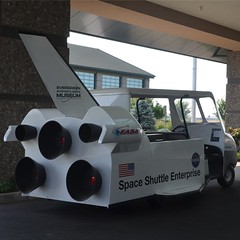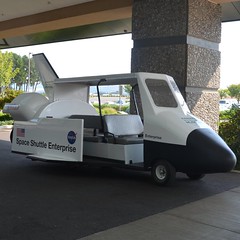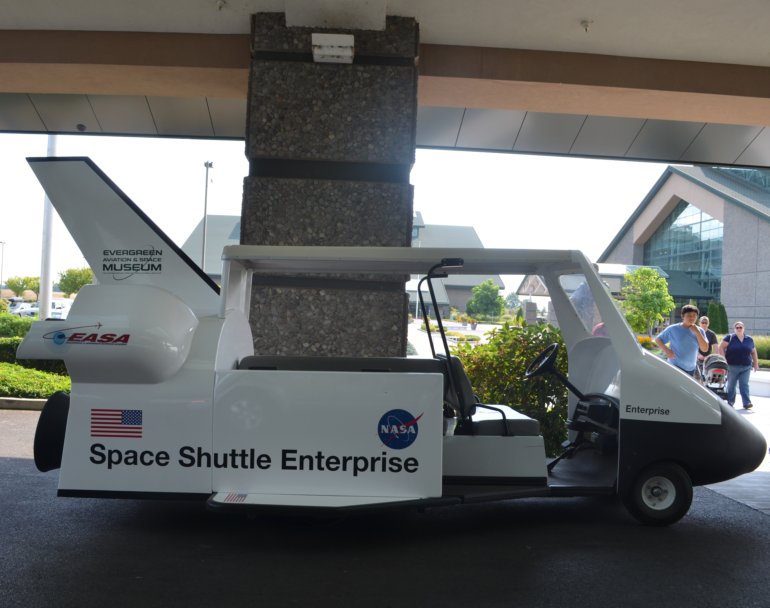That ride to Lincoln City took me along the same route that Mama and I followed many times to Spirit Mountain Casino where we had fun playing the penny machines. I had not been that way since she died in January, and I am so glad that I had family and friends with me as memories flooded in continually.

One of the things that Mama and I did was to drive through the grounds of the Evergreen Aviation & Space Museum and Wings & Waves Waterpark in McMinnville, Oregon. First thing that caught my eye, the 747 on top of the waterpark. Yes, on top of the waterpark which is inside the building which houses 10 waterslides, a wave pool and a children's museum which teaches all about the power of water. You can see some of the waterslides coming out of the plane!



Second thing that caught my eye, this shuttle used by the museum to transport folks between buildings and vehicles, I'm guessing. Cool design!

And the last thing that caught my eye, something I will go inside and see one day, is the Spruce Goose, the largest plane ever built. I pulled to a stop in front of the building and took this photo through the front passenger window. With the help of Picnik, you can see it pretty well through the glass wall, all four engines on the wing to the right and just one of them on the wing to the left. The plane's wingspan is 319 feet, 11 inches. See the white dot there toward the left at the bottom of the photo, right at the second open window? That is a man's ball cap! Yep, a full grown man! He's facing the window, looking down at one of several display panels which surely tell the story of this gigantic airplane. And be sure to notice the tail, right up there close to the American flag. The plane's height is 79 feet 4 inches, which I assume is from the tip of the tail down because I also found this statistic, fuselage height 30 feet.
Here's what I found out about it on their Web site: Built entirely of wood due to wartime restrictions on metals, this massive airplane stands as a symbol of American industry during World War II. Learn more about the history, first flight, and legacy of this mammoth plane. The largest airplane ever constructed, and flown only one time, the Spruce Goose represents one of man’s greatest attempts to conquer the skies. It was born out of a need to move troops and material across the Atlantic Ocean, where in 1942, German submarines were sinking hundreds of Allied ships. Henry Kaiser, steel magnate and shipbuilder, conceived the idea of a massive flying transport and turned to Howard Hughes to design and build it. Hughes took on the task, made even more challenging by the government’s restrictions on materials critical to the war effort, such as steel and aluminum. Six times larger than any aircraft of its time, the Spruce Goose, also known as the Flying Boat, is made entirely of wood. Originally designated HK-1 for the first aircraft built by Hughes-Kaiser, the giant was re-designated H-4 when Henry Kaiser withdrew from the project in 1944. Nevertheless, the press insisted on calling it the “Spruce Goose” despite the fact that the plane is made almost entirely of birch. The winged giant made only one flight on November 2, 1947. The unannounced decision to fly was made by Hughes during a taxi test. With Hughes at the controls, David Grant as co-pilot, and several engineers, crewmen and journalists on board, the Spruce Goose flew just over one mile at an altitude of 70 feet for one minute. The short hop proved to skeptics that the gigantic machine could fly. Perhaps always dreaming of a second flight, Hughes retained a full crew to maintain the mammoth plane in a climate-controlled hangar up until his death in 1976.

4 comments:
Interesting aviation history. Howard Hughes was one of a kind.
Interesting post and photos today, Lynette. The plane atop the building requires a double take. And I saw the Spruce Goose several times when it was in Long Beach.
Nice post, I can't believe that big plane is on top of that building.
I always marvel at the Spruce Goose when we drive by ... but I've never been to the museum. I had heard they built the waterpark, but I haven't been by since they built it. Sigh.
Post a Comment